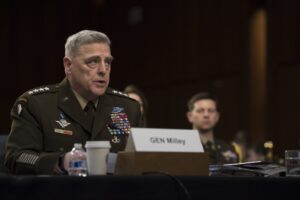The Chairman of the Joint Chiefs of Staff on Thursday characterized the Battle Force 2045 future fleet plans as more aspirations than clearly planned objectives but nevertheless are needed for great power competition and maintaining military superiority to China.
In October, former Secretary of Defense Mark Esper outlined the new Navy future fleet plan, called Battle Force 2045, calling for 500 ships by 2045 including many unmanned vessels and 355 traditional ships by 2035 (Defense Daily, Oct. 6).

“Now a lot of people – eyebrows got raised at that. Said wait a second, 500 ships, why 500, that’s an arbitrary number, you can’t afford it, the country can’t afford that,” Gen. Mark Milley said while speaking at the virtual USNI Defense Forum Washington on Thursday.
Milley admitted while “the critics may be right in many ways,” the final number is not the important part.
“The point is that’s an aim point, that’s a march objective, that’s an aspiration because we think that we …are going to have to have not only highly capable but we’re going to have to have a lot of ships. You’re going to have to have a much larger fleet than we have today if we’re serious about great power competition and deterring great power war and you’re serious about having dominant capability over something like China or some other power that has significant capability.”
Milley added that if they are serious about being in that position vis-à-vis China, “500 is probably your entrance ticket to a competition like that.”
Battle Force 2045 calls for the fleet to reach 140 to 240 unmanned and optionally manned surface and underwater vessels.
“That’s a huge transformation of not only our Navy, but that will be a shock to the entire world. To have that percentage, 25 percent, maybe even more, of the fleet as sailorless – that’s as big a change as going from sail to coal, from going from wood to steel. That’s a big deal in the introduction of robotics,” Milley said.
He noted that under this plan by 2035 60 to 70 percent of that fleet, realistically, will look “very similar” to today’s fleet.
“And that is just a reality check on the speed at which weapons systems can be developed & fielded and tested and so on and so forth…but we will begin, we’ll be on a path to that fleet of 2045.”
Milley also explained the military’s approach to the future carrier force, which has spurred significant debate.
Battle Force 2045 outlined the nuclear-powered carriers (CVNs) will eventually lower to the current 11 to the eight to 11 range while also adding up to six light carriers, which Milley referred to with a World War II nickname as jeep carriers.
“I don’t know how many meetings I’ve been in on the carriers – I do not recommend and would not recommend replacing the fleet carriers, the CVNs that we have, 11, unless there was something better to replace it. So I’m one of these – don’t throw the baby out with the bathwater yet, don’t get rid of the horse cavalry until you have a tank.”
However, he underscored carriers are likely to be significant targets of China in a future conflict as they develop their anti-access and area denial (A2/AD) capabilities.
“Do we really want a ship with four, five thousand U.S. sailors on it at that level of risk?”
He said DoD needs to do something to make the carrier fleet more survivable, distributed, and less of a target.
Milley teased there are things they can do to hide the ships to some degree, but it is still problematic to have the big targets on the ocean.
He characterized the plan as it stands as sticking with 11 carriers until there is something else and they want to explore the utility of smaller light carriers.
“So maybe we have five or six jeep carriers and maybe once those are commissioned, they’re at sea, they’ve gone through their trials, then maybe you think about coming down from 11 to some other number. But we’re not sure yet.”
In October, Chief of Naval Operations Adm. Mike Gilday said the light carrier options allow the Defense Department to do a deeper analysis to see what functions a smaller aviation combatant might perform. He noted light carriers could focus on intelligence, surveillance, reconnaissance and targeting (ISR&T) (Defense Daily, Oct. 13).
Separately, Milley promoted the plan for more submarines as well, but he was realistic about what the final numbers could be.
“The one we are very certain we need to expand, very quickly, are subs. We know subs are survivable, we know U.S. subs are survivable…and we know that and we need to expand it.”
Battle Force 2045 calls for a future submarine force of 70 to 80 submarines, with Esper at the time saying the Navy needed to at least move to building two Virginia-class attack submarines per year.
“Will we hit those exact numbers on those exact times? No, but it’s the idea, it’s the concept that this is what America is going to need if we define our role in the world,” Milley said.